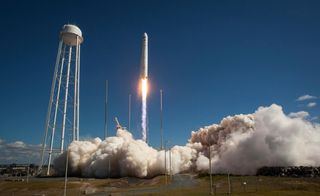According to Newtons third law, what happens when you push against a wall?
Equal & Opposite Reactions: Newton'due south Third Police of Motion

Isaac Newton's Second Law of Motion describes what happens when an external force acts upon a massive trunk at rest or in compatible linear motion. What happens to the body from which that external forcefulness is being applied? That situation is described by Newton's 3rd Law of Motion. Information technology states, "For every action, there is an equal and reverse reaction."
Newton published his laws of motility in 1687, in his seminal work "Philosophiæ Naturalis Principia Mathematica" (Mathematical Principles of Natural Philosophy) in which he formalized the description of how massive bodies move nether the influence of external forces.
Newton expanded upon the before work of Galileo Galilei, who adult the first accurate laws of motion for masses, according to Greg Bothun, a physics professor at the University of Oregon. Galileo'due south experiments showed that all bodies accelerate at the aforementioned rate regardless of size or mass. Newton likewise critiqued and expanded on the work of Rene Descartes, who likewise published a ready of laws of nature in 1644, two years subsequently Newton was built-in. Descartes' laws are very like to Newton's first law of motion.
Pushback
Forces always occur in pairs; when one body pushes against some other, the 2d body pushes dorsum just every bit hard. For case, when you push button a cart, the cart pushes back against you; when you pull on a rope, the rope pulls back against y'all; and when gravity pulls y'all downward confronting the basis, the ground pushes up confronting your feet. The simplified version of this phenomenon has been expressed equally, "You cannot touch without being touched."
If body A exerts a forcefulness F on body B, then body B exerts an equal and opposite force −F back on body A. The mathematical expression for this is F AB = −F BA
The subscript AB indicates that A exerts a strength on B, and BA indicates that B exerts a force on A. The minus sign indicates that the forces are in opposite directions. Often F AB and F BA are referred to as the action force and the reaction force; however, the pick of which is which is completely arbitrary.
If 1 object is much, much more massive than the other, particularly in the case of the first object being anchored to the Earth, nearly all of the acceleration is imparted to the second object, and the acceleration of the first object tin be safely ignored. For instance, if you were to plant your feet and throw a baseball to the due west, you would non have to consider that you actually caused the rotation of the World to speed upwardly slightly while the ball was in the air. However, if you were continuing on roller skates, and you threw a bowling ball forrard, you would start moving backward at a noticeable speed.
Ane might ask, "If the two forces are equal and contrary, why do they non abolish each other out?" Really, in some cases they practice. Consider a book resting on a table. The weight of the book pushes down on the table with a force mg, while the table pushes upwardly on the book with an equal and opposite forcefulness. In this case, the forces cancel each other because the volume does not accelerate. The reason for this is that both forces are acting on the same body, while Newton's 3rd Law describes two different bodies acting on each other.
Consider a horse and a cart. The equus caballus pulls on the cart, and the cart pulls back on the horse. The two forces are equal and opposite, so why does the cart movement at all? The reason is that the horse is also exerting a force on the ground, which is external to the equus caballus-cart system, and the ground exerts a force dorsum on the horse-cart system causing it to accelerate.
Newton's third constabulary in activeness
Rockets traveling through space embrace all three of Newton's laws of motion.
When the engines fire and propel the rocket forrard, it is the result of a reaction. The engine burns fuel, which is accelerated toward the rear of the transport. This causes a force in the opposite management to push button the rocket forward. Thrusters can also be used on the sides of the rocket to get in change direction, or on the front to create a backwards forcefulness to slow the rocket downwards.
And if, while working on the outside of the rocket, the astronaut'south rope breaks and they drift away from the rocket, they tin utilise one of their tools, for instance, to change directions and get back to the rocket. The astronaut tin throw their hammer in the direction directly opposite of where they want to get. The hammer will go flight off very chop-chop abroad from the rocket and the astronaut volition very slowly travel back to the rocket. This is why Newton's Tertiary Constabulary is considered to be the fundamental principle of rocket science.
Additional reporting past Rachel Ross, Alive Science contributor.
See likewise:
- Newton'southward Laws of Motion
- Inertia & Newton's First Law of Movement
- Force, Mass & Acceleration: Newton'south Second Law of Motion
Source: https://www.livescience.com/46561-newton-third-law.html
0 Response to "According to Newtons third law, what happens when you push against a wall?"
Post a Comment